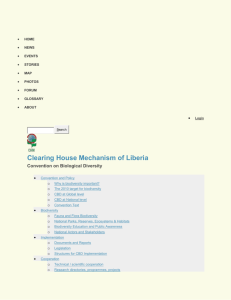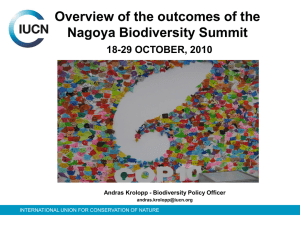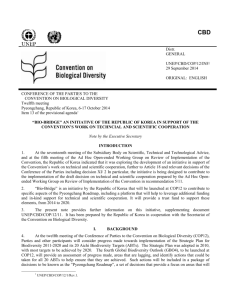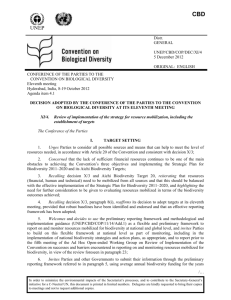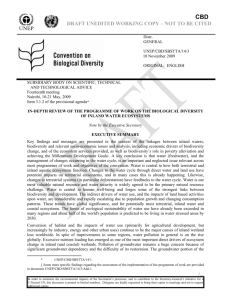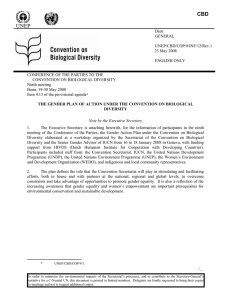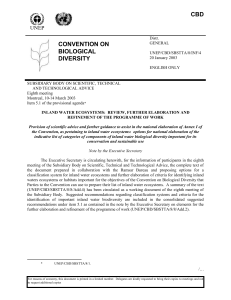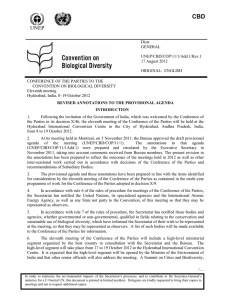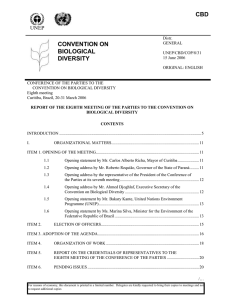XI/23. Biological diversity of inland water ecosystems
advertisement
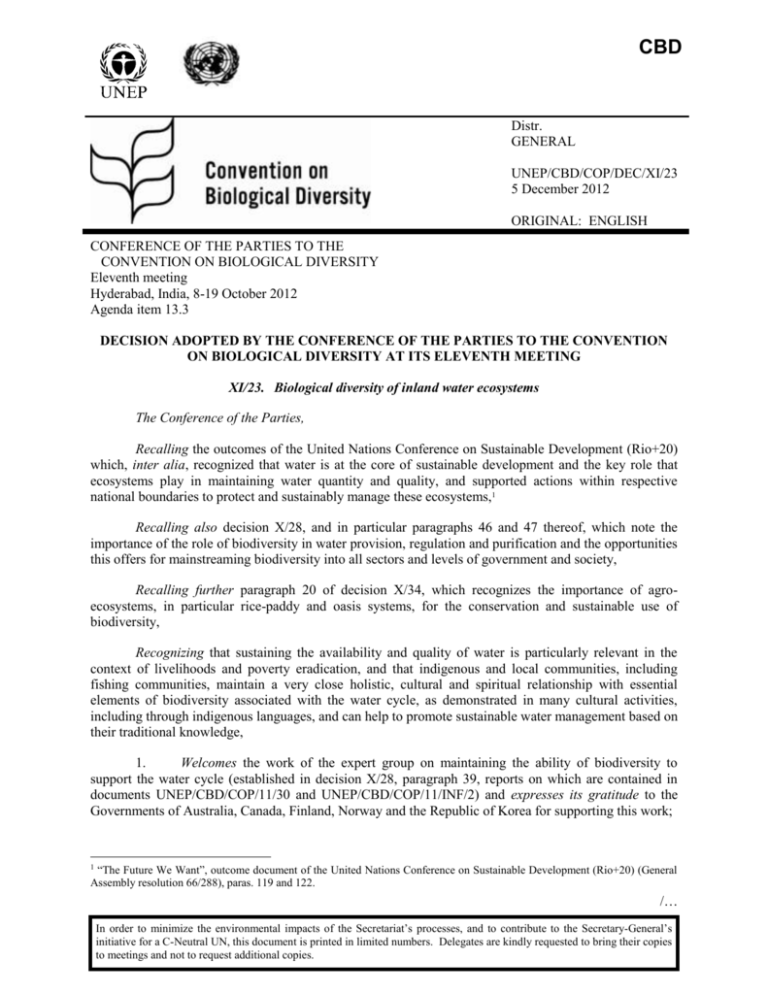
CBD Distr. GENERAL UNEP/CBD/COP/DEC/XI/23 5 December 2012 ORIGINAL: ENGLISH CONFERENCE OF THE PARTIES TO THE CONVENTION ON BIOLOGICAL DIVERSITY Eleventh meeting Hyderabad, India, 8-19 October 2012 Agenda item 13.3 DECISION ADOPTED BY THE CONFERENCE OF THE PARTIES TO THE CONVENTION ON BIOLOGICAL DIVERSITY AT ITS ELEVENTH MEETING XI/23. Biological diversity of inland water ecosystems The Conference of the Parties, Recalling the outcomes of the United Nations Conference on Sustainable Development (Rio+20) which, inter alia, recognized that water is at the core of sustainable development and the key role that ecosystems play in maintaining water quantity and quality, and supported actions within respective national boundaries to protect and sustainably manage these ecosystems,1 Recalling also decision X/28, and in particular paragraphs 46 and 47 thereof, which note the importance of the role of biodiversity in water provision, regulation and purification and the opportunities this offers for mainstreaming biodiversity into all sectors and levels of government and society, Recalling further paragraph 20 of decision X/34, which recognizes the importance of agroecosystems, in particular rice-paddy and oasis systems, for the conservation and sustainable use of biodiversity, Recognizing that sustaining the availability and quality of water is particularly relevant in the context of livelihoods and poverty eradication, and that indigenous and local communities, including fishing communities, maintain a very close holistic, cultural and spiritual relationship with essential elements of biodiversity associated with the water cycle, as demonstrated in many cultural activities, including through indigenous languages, and can help to promote sustainable water management based on their traditional knowledge, 1. Welcomes the work of the expert group on maintaining the ability of biodiversity to support the water cycle (established in decision X/28, paragraph 39, reports on which are contained in documents UNEP/CBD/COP/11/30 and UNEP/CBD/COP/11/INF/2) and expresses its gratitude to the Governments of Australia, Canada, Finland, Norway and the Republic of Korea for supporting this work; “The Future We Want”, outcome document of the United Nations Conference on Sustainable Development (Rio+20) (General Assembly resolution 66/288), paras. 119 and 122. 1 /… In order to minimize the environmental impacts of the Secretariat’s processes, and to contribute to the Secretary-General’s initiative for a C-Neutral UN, this document is printed in limited numbers. Delegates are kindly requested to bring their copies to meetings and not to request additional copies. UNEP/CBD/COP/DEC/XI/23 Page 2 2. Notes that the findings of The Economics of Ecosystems and Biodiversity (TEEB) report on the economics of water and wetlands (UNEP/CBD/COP/11/INF/22) affirm the major importance and value of the diverse range of services, and particularly water-related services, delivered by the water cycle in both coastal and inland wetlands; and expresses its gratitude to the Governments of Norway, Switzerland and Finland and the International Union for Conservation of Nature for supporting this work; 3. Recognizes the importance of the water cycle, including its groundwater component, and the influence of climate change upon it, to most areas of work of the Convention and to achieving most of the Aichi Biodiversity Targets, and urges Parties, other Governments and relevant organizations, and requests the Executive Secretary, to give due consideration to the water cycle, as a cross-cutting theme, when implementing the Strategic Plan for Biodiversity 2011–2020; 4. Requests the Executive Secretary, and invites the Secretary General of the Ramsar Convention on Wetlands, under the Joint Work Plan between the Convention on Biological Diversity and the Ramsar Convention, and in consultation with relevant organizations and initiatives, to develop a cooperative partnership to promote awareness of, and capacity-building for, ecosystem-based solutions for water resources management as a means to enhance the implementation of the Strategic Plan for Biodiversity 2011 – 2020 by the broadest range of stakeholders, as a contribution to sustainable development and to the United Nations International Year of Water Cooperation (2013), and to make a progress report available to Parties prior to, and for the consideration of, the twelfth meeting of the Conference of the Parties; 5. Notes that the term “wetland”, as defined by the Ramsar Convention, offers flexible scope for national interpretation for addressing biodiversity challenges related to ecological inter-linkages between inland, coastal and marine areas, and invites Parties and other Governments to consider wider adoption of the term in implementing the Convention on Biological Diversity, particularly for achieving Aichi Biodiversity Target 11; 6. Invites Parties, other Governments and relevant organizations to take note that the year 2013 will be the United Nations International Year of Water Cooperation and that this, together with the current “International Decade for Action 'Water for Life' 2005-2015”, provides opportunities to bring water and biodiversity issues to broad public attention, and also to aim to achieve greater synergies between the Convention on Biological Diversity and related multilateral environmental agreements, such as the Ramsar Convention on Wetlands, the Convention on Migratory Species and the African-Eurasian Waterbird Agreement, including synergies between their respective governing bodies and reporting requirements; 7. Urges Parties and other Governments to ensure, where relevant, the full and effective participation of indigenous and local communities in the implementation of actions related to the biological diversity of inland water ecosystems. -----

